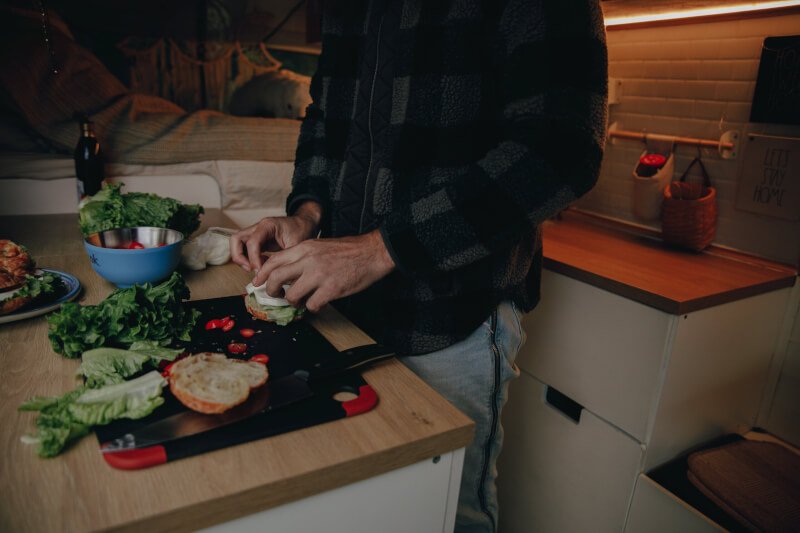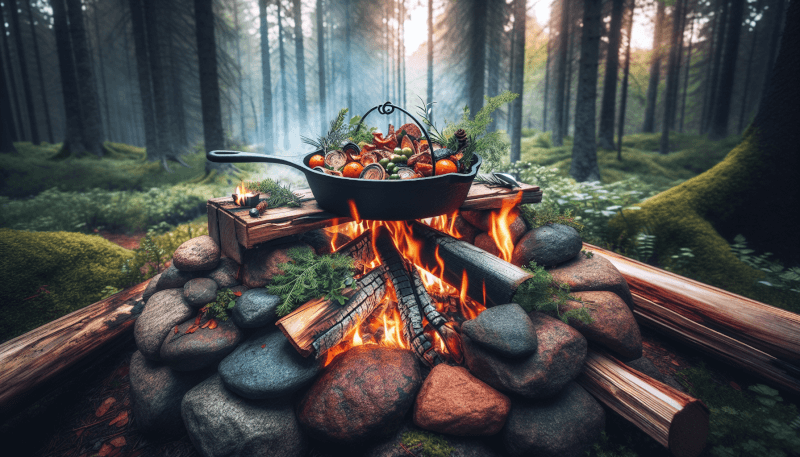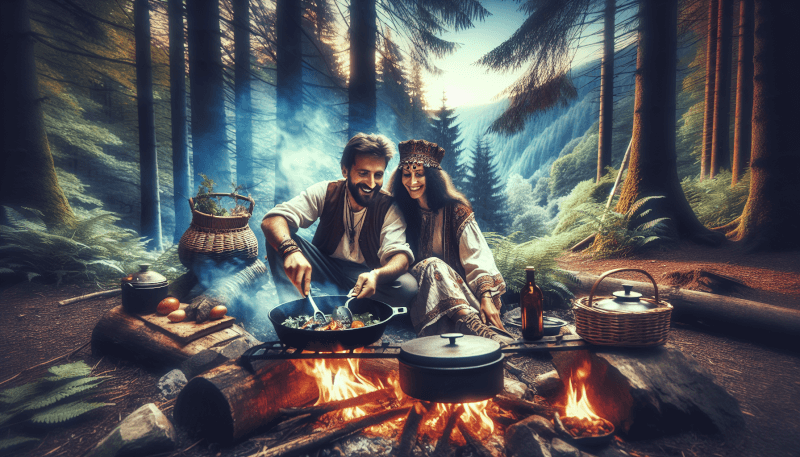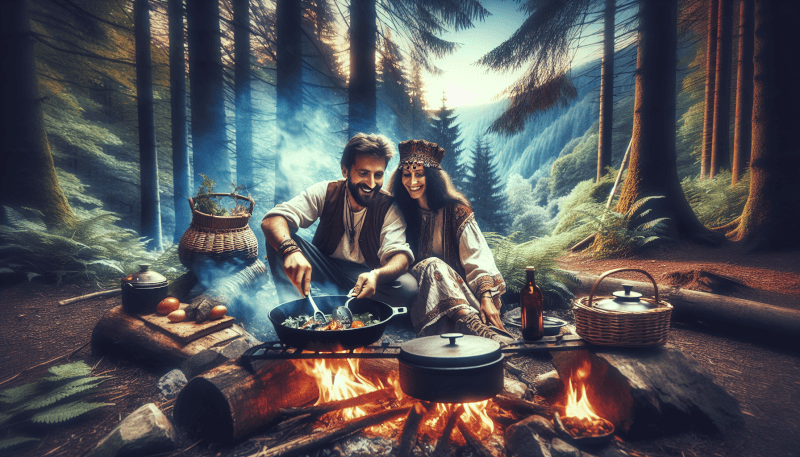Imagine being able to prepare a delicious meal in the great outdoors, surrounded by the beauty of nature. In this article, you will discover the art of cooking in the wild, where rustic simplicity meets culinary creativity. From open fires and cast-iron pots to foraging for fresh ingredients, we will explore the various techniques and strategies that will transform your camping or hiking trips into unforgettable gastronomic adventures. Get ready to embark on a culinary journey under the open sky and savor the flavors of the wilderness.
Benefits of Cooking in the Wild
Healthy and Nutritious Meals
Cooking in the wild offers numerous benefits, one of which is the ability to prepare healthy and nutritious meals. When you cook your own food outdoors, you have complete control over the ingredients you use. This means you can choose fresh, organic produce and locally sourced meat, ensuring that your meals are filled with essential nutrients.
Additionally, cooking in the wild often involves using minimal processing techniques, which helps to retain the nutritional value of the food. Grilling, boiling, and roasting are common cooking techniques in the wild that require little to no added fats or oils, making the meals not only healthy but also low in calories.
Enhances Survival Skills
Cooking in the wild also enhances your survival skills. When you find yourself in a wilderness setting with limited resources, cooking becomes more than just a way to satisfy your hunger. It becomes a skill that allows you to sustain yourself in challenging conditions.
By learning how to build a campfire, identify edible plants, and forage for ingredients, you become more self-sufficient in the wilderness. These skills not only ensure you have food to eat but also build your confidence and ability to adapt to different situations.
Connects with Nature
One of the most significant benefits of cooking in the wild is the connection it fosters with nature. When you prepare meals outdoors, you are immersed in the natural beauty of your surroundings. The fresh air, the sounds of the wilderness, and the breathtaking landscapes all contribute to a sense of tranquility and appreciation for the environment.
Cooking in the wild also allows you to experience nature in a more intimate way. As you gather firewood, forage for ingredients, and cook them over an open flame, you develop a deep respect for the food and resources provided by nature. This connection with the natural world can be incredibly grounding and fulfilling.
Essential Equipment for Cooking in the Wild
Campfire Cooking Utensils
When cooking in the wild, having the right utensils can make a world of difference. Campfire cooking utensils are designed to withstand high heat and rugged conditions. Some essential utensils include:
Campfire grill grate: A sturdy grill grate allows you to cook meat, fish, and vegetables directly over an open flame, achieving that delicious smoky flavor.
Campfire tripod: A tripod with a cooking grate suspended over the firepit enables you to adjust the height of your cooking surface, allowing for more precise temperature control.
Cast iron skillet: A cast iron skillet is a versatile tool that can be used for frying, sautéing, and baking in the campfire. It distributes heat evenly and retains heat well, making it perfect for outdoor cooking.
Portable Stoves
Although cooking over a campfire is a classic method, sometimes a portable stove can be more convenient, especially in areas where open fires are prohibited or during inclement weather. Portable stoves offer ease of use and stability, ensuring your meals are cooked to perfection. There are various types of portable stoves available, including propane, butane, and multi-fuel stoves. Choose one that suits your needs and is compatible with your cooking utensils.
Cooking Pots and Pans
Investing in a set of sturdy, lightweight camping pots and pans is essential for cooking in the wild. Look for pots and pans made from durable materials such as stainless steel or titanium, as they are both lightweight and resistant to wear and tear. Make sure to choose a set that includes different sizes to accommodate a variety of ingredients and cooking techniques.

Building a Campfire
Choosing a Suitable Location
Selecting the right location for your campfire is crucial for both safety and optimal cooking conditions. Look for a spot that is at least 15 to 20 feet away from any tents, trees, or other flammable materials. Clear away any dry leaves or debris from the area, ensuring that the ground is solid and stable.
It’s also important to consider wind direction when choosing a location. Avoid cooking in an area where the wind could blow sparks or flames towards your campsite or surrounding vegetation. Additionally, be mindful of any local regulations or fire restrictions that may be in place.
Gathering Firewood
Before you start your campfire, gather an ample supply of firewood. Look for dead branches and fallen logs, as they make excellent fuel for cooking fires. Ensure that the wood you collect is dry and sufficiently aged, as damp or green wood can emit excessive smoke and be difficult to ignite.
When gathering firewood, remember to follow the principles of Leave No Trace. Only take what you need and avoid damaging live trees or vegetation. Respect the natural environment and leave it as you found it for others to enjoy.
Creating the Fire Pit
Once you have chosen a suitable location and gathered your firewood, it’s time to create a fire pit. A well-designed fire pit provides stability and proper ventilation for your campfire.
Begin by clearing a circular area approximately three feet in diameter. Dig a shallow pit in the center, about six to eight inches deep. This pit will contain the fire and allow for controlled cooking. Use the excess dirt to build a small barrier around the pit, which serves to further contain the fire.
For added safety, surround the fire pit with rocks or stones, leaving a space of about six inches between the edge of the pit and the rocks. This helps prevent sparks from escaping and keeps the fire contained in the designated area.
Cooking Techniques in the Wild
Grilling
Grilling over an open flame is one of the most popular cooking techniques in the wild. Whether you’re cooking meat, fish, or vegetables, grilling imparts a delightful smoky flavor and enhances the natural taste of the ingredients.
To grill food in the wild, make sure your campfire is reduced to hot coals before placing the grill grate over it. This ensures even heat distribution and prevents excessive charring. Season your ingredients with herbs, spices, and marinades to add flavor, then place them directly on the grill grate. Turn the food occasionally to ensure even cooking and achieve that perfect charred exterior.
Boiling
Boiling is a simple yet effective cooking technique in the wild, especially when preparing soups, stews, or pasta dishes. It requires minimal equipment and is an excellent method for cooking ingredients quickly.
To boil water or cook food using this technique, fill a pot with water and place it directly over the fire or portable stove. Once the water reaches a rolling boil, you can add ingredients such as pasta or vegetables. Boiling times may vary depending on the type of food, so it’s important to monitor the cooking process closely.
Roasting
Roasting food over an open flame is a classic cooking technique that can be easily mastered in the wild. It’s perfect for cooking meat, fish, root vegetables, and even fruits.
To roast food, skewer it on a long, sturdy stick or use a specialized roasting fork. Hold the food over the fire, rotating it slowly to ensure even cooking. The distance between the food and the flames can be adjusted to control the cooking temperature. Use an instant-read thermometer to check the internal temperature of meat to ensure it is safe to eat.

Foraging for Ingredients
Identifying Edible Plants
Foraging for edible plants adds an exciting and sustainable element to cooking in the wild. However, it’s essential to have proper knowledge and expertise to accurately identify edible plants to avoid any potential risks.
Before consuming any wild plants, educate yourself on plant identification and consult reliable field guides or experts. Look for common edible plants such as dandelion, nettles, wild garlic, and wild berries. These can be used to enhance flavors, add nutritional value, or even create unique dishes that celebrate nature’s abundance.
Harvesting Wild Berries and Nuts
Wild berries and nuts are often abundant in many regions, providing a delicious addition to your outdoor meals. Blueberries, raspberries, blackberries, and strawberries can all be found in the wild and make excellent toppings for pancakes, porridge, or desserts.
When harvesting wild berries, ensure they are ripe and avoid picking any that appear mouldy or damaged. Nuts, such as walnuts, hazelnuts, and cashews, can also be foraged in certain areas. Crack them open using a rock or specialized nutcracker and enjoy their natural flavor and nutritional benefits.
Fishing and Hunting
For those with advanced wilderness skills and the appropriate permits, fishing and hunting provide an unrivaled opportunity to incorporate fresh, locally sourced protein into your outdoor meals. Catching fish or hunting game adds a primal element to your cooking experience and allows you to truly connect with nature.
Before embarking on any fishing or hunting activities, familiarize yourself with local regulations and ethical guidelines. Practice responsible fishing and hunting techniques to ensure the sustainability of fish and wildlife populations.
Preparing and Storing Food in the Wild
Basic Food Safety Practices
Maintaining basic food safety practices is essential when cooking in the wild to prevent foodborne illnesses. Here are some important guidelines to follow:
Cleanliness: Wash your hands thoroughly with soap and water before handling food. If clean water is not available, use hand sanitizer.
Food Separation: Keep raw meat, fish, and poultry separate from other ingredients to avoid cross-contamination. Use separate cutting boards and utensils for each type of food.
Proper Cooking Temperatures: Make sure your food reaches the appropriate internal temperature to kill harmful bacteria. Use a meat thermometer to check the temperature of cooked meats.
Hydration: Stay hydrated by drinking clean, filtered water to prevent dehydration and promote overall well-being.
Proper Storage of Perishable Food
When cooking in the wild, it’s crucial to have a plan for storing perishable food properly. Without refrigeration, perishable items like meat, dairy products, and fresh produce can spoil quickly in warm temperatures.
Consider freezing meat and other perishables before your camping trip. This will buy you some time before they start to thaw and spoil. Use a well-insulated cooler with ice packs or dry ice to keep your food chilled for longer periods. Remember to keep the cooler in a shaded area and avoid opening it frequently to maintain cold temperatures.
Using Natural Preservatives
Nature provides several natural preservatives that can help extend the shelf life of certain foods when cooking in the wild. These include:
Salt: Salt is a versatile preservative that can be used to cure or dry food, preventing spoilage. It also enhances flavors and can act as a seasoning.
Vinegar: Vinegar has antimicrobial properties that inhibit the growth of bacteria. It can be used to preserve fruits, vegetables, and even meat.
Smoking: Smoking food not only imparts a unique flavor but also helps to preserve it. The smoke acts as a barrier, inhibiting the growth of bacteria and preventing spoilage.
Knowing how to use these natural preservatives can ensure that your ingredients stay fresh for longer, allowing you to enjoy them throughout your outdoor adventure.

Delicious Recipes for Cooking in the Wild
Campfire Grilled Fish
Ingredients:
- Fresh fish fillets (such as trout or salmon)
- Lemon slices
- Fresh herbs (such as dill or thyme)
- Salt and pepper to taste
Instructions:
- Preheat the campfire grill grate over hot coals.
- Season the fish fillets with salt, pepper, and your choice of fresh herbs.
- Place the fillets on the grill grate and cook for about 4-6 minutes per side, depending on the thickness of the fish.
- Add a few slices of lemon on top of each fillet during the last 2 minutes of cooking.
- Remove the fish from the grill and serve hot with a squeeze of lemon juice. Enjoy!
Wild Mushroom Risotto
Ingredients:
- Assorted wild mushrooms (such as chanterelles, porcini, or morels)
- Arborio rice
- Onion, finely chopped
- Garlic cloves, minced
- Vegetable or chicken stock
- Parmesan cheese, grated
- Butter
- Fresh thyme leaves
- Salt and pepper to taste
Instructions:
- In a large skillet, melt butter over medium heat. Add the chopped onion and minced garlic and sauté until translucent.
- Add the assorted wild mushrooms and cook until they release their moisture and become tender.
- Stir in the Arborio rice and cook for 1-2 minutes, allowing the grains to toast slightly.
- Gradually add the vegetable or chicken stock, stirring constantly until the liquid is absorbed. Continue adding stock and stirring until the rice is cooked al dente.
- Stir in grated Parmesan cheese and fresh thyme leaves. Season with salt and pepper to taste.
- Remove from heat and let the risotto rest for a few minutes before serving. Enjoy the rich and earthy flavors of your wild mushroom risotto!
Fire-roasted Vegetables
Ingredients:
- Assorted vegetables (such as bell peppers, zucchini, eggplant, and corn on the cob)
- Olive oil
- Balsamic vinegar
- Fresh herbs (such as rosemary or basil)
- Salt and pepper to taste
Instructions:
- Preheat the campfire grill grate over hot coals.
- While the grill is heating, brush the vegetables with olive oil and season with salt and pepper.
- Place the vegetables on the grill grate, ensuring they are evenly spaced.
- Cook the vegetables, turning occasionally, until they are charred and tender.
- Remove the vegetables from the grill and drizzle with balsamic vinegar. Sprinkle with fresh herbs for added flavor.
- Serve the fire-roasted vegetables as a side dish or as a flavorful addition to any meal. Enjoy the smoky goodness of these grilled veggies!
Tips for Cooking in Extreme Wilderness
Dealing with Limited Resources
In extreme wilderness settings, it’s important to be prepared for limited resources. Here are some tips to help you adapt:
Plan Ahead: Research and plan your meals in advance, ensuring you have enough food and ingredients for the duration of your trip.
Lightweight Ingredients: Opt for lightweight ingredients that are easy to carry, such as dehydrated or freeze-dried meals, trail mix, and instant or quick-cooking foods.
Minimalist Cooking: Embrace minimalist cooking techniques that require fewer utensils or equipment. For example, opt for one-pot meals or use foil packets for easy cooking and cleanup.
Prioritize Water: Water is essential for cooking and hydration. Plan your cooking around available water sources and bring a reliable water purification system to ensure a safe and continuous water supply.
Adapting to Seasonal Ingredients
When cooking in the wild, the availability of ingredients may vary depending on the season. Here are some tips for adapting to seasonal ingredients:
Know the Local Flora and Fauna: Research the region you will be visiting to learn about the local plants, fruits, vegetables, and wildlife that may be available during your trip.
Embrace Seasonal Eating: Embrace the seasonal bounty by incorporating local ingredients into your meals. By doing so, you can enjoy fresh and flavorful dishes that showcase the unique flavors of the season.
Preserve Ingredients: If you come across an abundance of fresh ingredients, consider preserving them for future use. Techniques such as drying, smoking, pickling, or making jams and jellies can help prolong the enjoyment of seasonal ingredients.
Minimizing Impact on the Environment
Cooking in the wild should always be done with a mindset of minimizing your impact on the environment. Here are some ways to practice leave-no-trace principles:
Use Existing Fire Rings: Whenever possible, use established fire rings to minimize the impact on the surrounding landscape. Avoid creating new fire pits unless absolutely necessary.
Leave No Trace: Ensure that you pack out all your trash, including food scraps and packaging. Dispose of waste properly and avoid littering or disturbing natural habitats.
Use Biodegradable Soap: When washing dishes or utensils, use biodegradable soap or environmentally friendly cleaning agents to minimize pollution to natural water sources.
Respect Wildlife: Observe wildlife from a distance and avoid feeding them. Respect their natural behaviors and habitats, and do not disturb their nests or dens.
By incorporating these principles into your cooking practices, you can enjoy the wilderness while leaving it untouched for future generations to appreciate.

Safety Precautions when Cooking in the Wild
Fire Safety
When cooking in the wild, fire safety should be a top priority. Follow these guidelines to prevent accidents and wildfires:
Follow Fire Regulations: Adhere to any local fire regulations or restrictions in the area you are camping. These regulations are designed to protect the environment and prevent wildfires.
Extinguish Fires Completely: Ensure that your campfire is fully extinguished before leaving the site or going to bed. Douse the fire with water and stir the ashes until no more heat or smoke remains.
Keep Fire Contained: Maintain a safe distance between your campfire and surrounding vegetation, tents, and other flammable materials. Use rocks or stones to create a barrier around the fire pit to prevent sparks from escaping.
Monitor Wind Conditions: Be mindful of wind conditions when cooking over an open flame. Avoid cooking in windy areas where sparks from the fire can be carried towards your campsite or surrounding vegetation.
Foodborne Illness Prevention
Preventing foodborne illnesses is crucial when cooking in the wild. Follow these safety tips to ensure the safety of your meals:
Proper Storage: Keep perishable food in a well-insulated cooler with ice packs to maintain a safe temperature. Avoid leaving food out for extended periods, especially in warm weather.
Cleanliness: Practice good hygiene by washing your hands thoroughly with soap and water before handling food. Clean utensils, cutting boards, and surfaces with hot, soapy water to prevent cross-contamination.
Cook Thoroughly: Use a meat thermometer to ensure that meats and other perishable items are cooked to the appropriate internal temperature to kill harmful bacteria.
Avoid Raw Meats: Minimize consumption of raw or undercooked meat, fish, and poultry to reduce the risk of foodborne illnesses. Thoroughly cook these foods to eliminate any potential pathogens.
Wildlife Encounters
Encountering wildlife can be thrilling, but it’s important to prioritize safety for both yourself and the animals. Follow these guidelines when cooking in areas with wildlife:
Secure Food and Garbage: Store food, garbage, and scented items securely in bear-resistant containers or hang them from a tree branch to prevent attracting wildlife to your campsite.
Cook Away from Sleeping Areas: Cook and eat meals away from sleeping areas to minimize the chance of attracting wildlife to your tent. This reduces the risk of dangerous encounters while you sleep.
Respect Wildlife’s Space: Observe wildlife from a distance and never approach, feed, or attempt to touch wild animals. Respect their natural behaviors and habitats for everyone’s safety.
Follow Local Guidelines: Familiarize yourself with any specific guidelines or regulations regarding wildlife encounters in the area you are camping and follow them accordingly.
By following these safety precautions, you can ensure a safe and enjoyable cooking experience while respecting the wilderness and its inhabitants.
Creative Ideas for Outdoor Cooking
One-pot Meals
One-pot meals are a convenient and versatile option for outdoor cooking. They require minimal cleanup and allow for endless variations. Whether you’re making a hearty chili, a flavorful curry, or a comforting stew, one-pot meals offer a satisfying and convenient solution for cooking in the wild.
Dutch Oven Cooking
Dutch ovens are a favorite among outdoor enthusiasts due to their versatility and ability to retain heat. From baking bread to slow-cooking meats and vegetables, a Dutch oven offers endless cooking possibilities. With a well-seasoned cast iron Dutch oven and some creativity, you can create delicious and hearty meals that rival those cooked in a traditional kitchen.
Wild Edibles in Baking
Incorporating wild edibles into your baking can add a unique and unexpected twist to your outdoor cooking experience. Try using wild berries in muffins, pancakes, or scones for a burst of natural sweetness. You can also experiment with edible flowers, such as lavender or violets, to infuse your baked goods with a delicate floral aroma.
Get creative with your outdoor cooking and explore the diverse flavors that nature has to offer. The possibilities are endless!
In conclusion, cooking in the wild offers numerous benefits, including the ability to prepare healthy and nutritious meals, enhance survival skills, and connect with nature. With the right equipment and knowledge, you can enjoy delicious meals while immersing yourself in the beauty of the great outdoors. Remember to prioritize safety, minimize your impact on the environment, and embrace the unique flavors and ingredients that the wilderness has to offer. Happy cooking in the wild!



